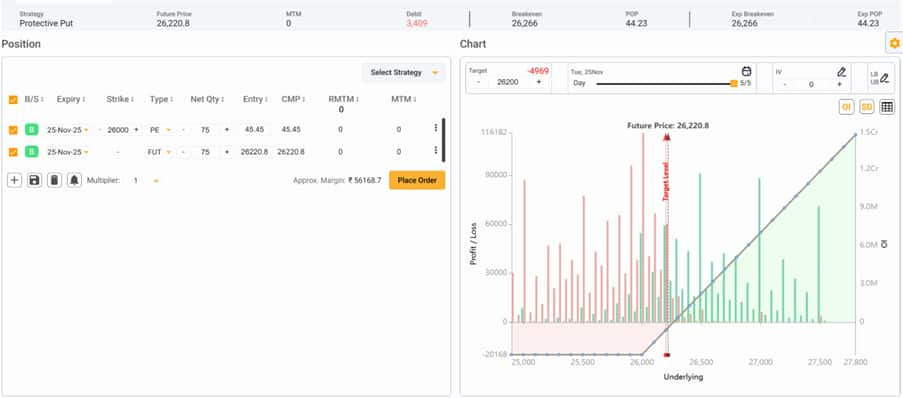Alternating your futures trades with 'deep-in-the-money options': Shubham Agarwal
In a favourable market 'deep-in-the-money options' allows almost similar participation to futures trading. In an adverse market, its non-linear behaviour, provides decent benefit.
SHUBHAM AGARWAL | 17-Apr-21
Reading Time: 3 minutes

Options as an instrument have gained a lot of popularity in recent years. Many directional traders use futures instrument to gain exposure for their directional bets.
These trades are generally an alternative to creating and holding portfolios for medium-term directional moves. Very often traders who migrate from futures to options, make mistakes in doing so.
In a hunt for cheaper options, traders’ resort to low premium OTM options but for such types of trades, the most apt option is buying 'deep-in-the-money options'. Let’s understand how to migrate our futures trades to options correctly.
Futures trade
While trading in futures, the general objective is to gain point-to-point participation in the underlying and this comes with a risk of open losses as in a buy trade the stock can correct to any level and in a sell trade the stock can rise to any level above. By using options, we can participate in similar moves, yet reducing our overall risk.
Benefits of deep-in-the-money options
Compared to ATM and OTM options, deep ITM options have a very low time value and is generally less affected with volatility . It provides almost a point-to-point participation in the expected direction, but in the case of a failure or pullback, it becomes non-linear, unlike futures that behave in a linear fashion. This non-linear behaviour improves the reward to risk to a great extent.
Option premiums despite being in the money are far cheaper than participating in a futures and if required can also provide better leverage.
Let’s understand what happens to our in the money options in different market scenarios:
1. Trending instrument in our expected direction: If the instrument trends in our expected direction, the option with delta being very close to 1 provides almost full participation. For instance, if the Nifty is trading at 14,700 currently and you buy a 14,000 CE, the delta of the option is 0.94 which is extremely close to 1. So, every 1 point of Nifty moving up, the option will move 0.94 points in that direction.
Now, let’s assume the Nifty reaches 14,800, the CE delta will increase to 0.98 providing a 0.98 points contribution for any further move. This way it provides the benefit of linearity just like a futures trade.
2. Sideways movement: In the case when the instrument does not move, due to the fact that you are buying options, certainly there is some theta decay but that is minimum. For example: if the Nifty 14000 CE is trading at 700 when the underlying future is at 14,650, if the Nifty does not move anywhere (which is an unlikely behaviour because there will be some movement or interim movement) for the entire expiry, all you lose is Rs 50. Thinking about why you would pay this cost let look at the benefit in the third scenario.
3. Trending move against expectation: In a scenario when the instrument fails to move in your expected direction is when the non-linear behaviour of options comes to a rescue and it stops declining to the extent the futures will correct. For example: if you bought the same Nifty 14,000 CE and the Nifty falls to 14,000 level, still the option premium of Rs 700 at the underlying level of 14,650 will now be priced at, 215 with underlying level of 14,000.
This means that where you could have lost Rs 650 in a futures trade, you will only pay Rs 485, that is a net benefit of Rs 165. In scenarios where an unknown large adverse move is witnessed this benefit will be even higher.
So, with the above example, we conclude that in a favourable market the deep-in-the-money options will allow almost similar participation and in an adverse market with its non-linear behaviour will provide a decent benefit. Hence, moving your futures trades with deep-in-the-money options could be a safer yet profitable bet.
Learn and read more about sgx nifty future from Quantsapp classroom which has been curated for understanding of option seller from scratch, to enable option traders grasp the concepts practically and apply them in a data-driven trading approach.
Recent Articles

Best trending option trading strategies: Shubham Agarwal
29-Nov-25

3 best ways to hedge using Options: Shubham Agarwal!
22-Nov-25

When in doubt to write, do Iron Fly: Shubham Agarwal!
15-Nov-25

Identify potential turning points with advance-decline: Shubham Agarwal
08-Nov-25

Slow and spreads more efficient: Shubham Agarwal
01-Nov-25

Use implied volatility as probable top finder: Shubham Agarwal
25-Oct-25

How to trade potential breakout post consolidation: Shubham Agarwal!
18-Oct-25

Use Options OI for intraday trading: Shubham Agarwal
11-Oct-25

SHUBHAM AGARWAL is a CEO & Head of Research at Quantsapp Pvt. Ltd. He has been into many major kinds of market research and has been a programmer himself in Tens of programming languages. Earlier to the current position, Shubham has served for Motilal Oswal as Head of Quantitative, Technical & Derivatives Research and as a Technical Analyst at JM Financial.
Recent Articles

Best trending option trading strategies: Shubham Agarwal
29-Nov-25 09:32:00

3 best ways to hedge using Options: Shubham Agarwal!
22-Nov-25 09:11:00

When in doubt to write, do Iron Fly: Shubham Agarwal!
15-Nov-25 10:48:00

Identify potential turning points with advance-decline: Shubham Agarwal
08-Nov-25 10:35:00

Slow and spreads more efficient: Shubham Agarwal
01-Nov-25 10:35:00

Use implied volatility as probable top finder: Shubham Agarwal
25-Oct-25 09:56:00

How to trade potential breakout post consolidation: Shubham Agarwal!
18-Oct-25 09:20:00











